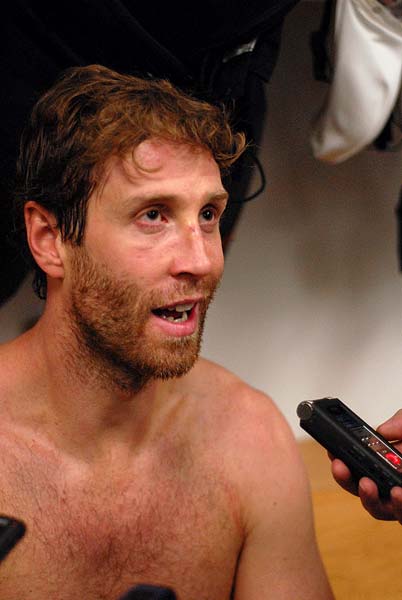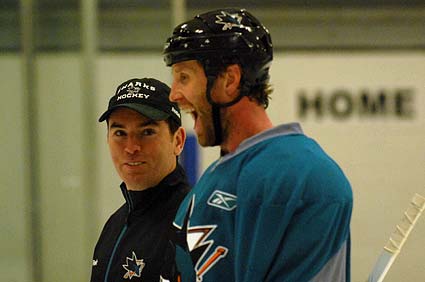Sharks captain Joe Thornton suspended two games for Perron hit, team expressed “confusion” at decision

SJ CAPTAIN JOE THORNTON SPEAKS WITH REPORTERS AFTER SUSPENSION

SJ ASST COACH JAY WOODCROFT, THORNTON DISCUSS FRI. PRACTICE
The NHL announced late this afternoon that Sharks captain Joe Thornton would receive a 2-game suspension after he was ejected from Thursday’s contest for a hit to St. Louis winger David Perron. The 13-year veteran will forfeit $77,419.36 in salary to the NHL Players’ Emergency Assistance Fund as a result of the suspension for what was termed an “illegal check to the head”.
San Jose Sharks EVP/GM Doug Wilson released a statement on the suspension via sjsharks.com. “We strongly disagree with the two-game suspension handed down by the NHL today to Joe Thornton,” Wilson said. “What is most distressing is that we feel the suspension is not consistent to the recent reviews by the League following similar collisions resulting in players leaving the penalty box and establishing their place on the ice, including Willie Mitchell on Jonathan Toews.”
The play differs from other rulings because Joe Thornton exited the penalty box and skated directly into the lane as David Perron looked behind him to accept a breakout pass from Alex Pietrangelo. In the NHL’s briefly worded statement, there was no acknowledgement that individual players have a responsibility to be aware of their surroundings. Perron skated through the neutral zone with his head down, and he kicked a breakout pass off his skates in a textbook invitation to a dangerous open ice hit. It is unclear, and certainly not definitive, that Thornton targeted the head of Perron or did so with an intent to injure.
“In Joe’s case, it was clearly not a predatory-type hit with an intent to injure, shown by the fact that the player returned to the ice for his next shift so it is clear that the contact to the head was minimal,” GM Doug Wilson continued. “We put a lot of time and effort into helping define the NHL’s new rule on headshots but we feel strongly that this suspension is not a reflection of the rule’s true intent.”
More than anger, after a short practice in San Jose on Thursday the team expressed a measure of confusion across the board. Defenseman Douglas Murray, who lead the team last year with 233 hits, said he did not know what type of hit was legal and what wasn’t. “I think it is more confusing, because I thought when we watched the video it was from where the hit was delivered.” Murray said. “The situation is worse too, with the guy laying down. He is out there playing the next shift.” After receiving brief medical attention, Perron was able to take his regular shift as the game resumed and he scored an insurance goal nearly 9 minutes later in the second period. “If you are laying down like that after a hit, you are not popping up and feeling ok.”
Thornton had a quizzical expression as he joined reporters to discuss the 2-game suspension after practice. “I was shocked to be honest with you,” Thornton said of the announcement. “I got text messages from over a dozen people that it probably should not have even been a penalty. To hear I had a disciplinary hearing this morning, I was shocked. To hear that I got 2 games…” Thornton had trouble finishing the sentence. “I think guys are real confused about what is a legal hit is now to be honest with you.”
What is and what is not legal deserves another look back at the newly implemented Rule 48, llegal Check to the Head. In the 2010-11 NHL Rulebook, rule 48.1 explicitly bans “lateral or blind side hits” where the head is targeted and/or is the principal point of contact. As is the case with many controversial plays, each camera angle can tell a different piece of the story, and sometimes watching a play live is the worst angle of all. None of the available camera angles had a clear view of the play in St. Louis. One top down angle shows Perron’s head violently snap back after the hit, while a closer ice level viewpoint shows Thornton leading with a shoulder (not an elbow), in what appears to be a perfectly legal position.
“Looking (at the hit) today, it was pretty black and white. It was a legal hit. I really don’t know how it can be perceived as a dangerous play on my part,” Thornton said. Describing the disciplinary hearing via conference call, a hearing conducted by NHL VP of Operations Mike Murphy with Colin Campbell unavailable, Thornton said he simply told his side of what happened. “I think last night Colin Campbell made up his mind that I was going to get the penalty, it didn’t really matter what happened today or what my explanation was.” The Sharks captain said it felt like a predetermined decision was made. “He already had this perceived notion, I am going to suspend Joe Thornton.”
Yahoo’s Greg Wyshynski opined today that a lack of injury, lack of intent, and the loss of the Sharks’ best player for 2/3rds of a conference rival game could have been mitigating factors, but “the NHL was continuing the education process for Rule 48.” Wyshynski believes it was a message sending statement in line with an earlier 3-game suspension the NHL handed down to Phoenix captain Shane Doan for his hit on Anaheim’s Dan Sexton.
Sending a message via Joe Thornton is an odd choice for the NHL, given the fact that he may be the star player least afforded protection by NHL officials from obstruction and hooking. At times Thornton looks like a 6-foot-4 tackling dummy as he sets up around the crease, if tackling dummies were meant to be chopped and hacked by Easton sticks. “They are obviously taking a stand,” defenseman Dan Boyle said. “Whether a guy is hitting, following through or not, whether he is being careful or trying to take a guy out. They are taking a stand.”
“It doesn’t matter (if star players are called). Players are in limbo on what is a clean and dirty hit,” Thornton said. “Players just don’t know, and that is a problem.”
TSN reporter Darren Dreger broke the news of the suspension earlier this afternoon on TSN. Dreger reported that agent John Thornton has the option to file an appeal with the NHLPA, but that the decision is “unlikely” to be overturned. The news was not confirmed by the NHL for an extended period, putting the Sharks organization in a difficult position. They have a team policy of not commenting on an incident until there is an official statement from the league. The league’s Sr. Director of Media Relations John Dellapina noted to Sharkspage this morning that they do not comment or issue statements unless a suspension or fine is made. Even then, they do not always acknowledge supplementary discipline hearings. The Sharks were forced to watch stories and blog posts move on the wire without an official team reaction. A hiccup to be sure, but one not conducive to an already borderline situation.
Thornton will be held out of the first 2 games of an upcoming 5-game homestand, November 6th against Tampa Bay, and November 9th against Anaheim. He will be eligible to return next Thursday against the New York Islanders.
It comes with the territory that media, fans and blogs are going to criticize officials for calls, and potentially criticize the league for decisions made based upon those calls. The NHL needs to follow two simple directives — protect the saftey of the players, and get calls right. For the second straight San Jose Sharks game, the officials and the league have failed on a fundamental level. To say the Sharks are angry may not be the most accurate description, they are frustrated by a league at times operating arbitrarily with no cohesive message.
The statement made with a 2-game suspension of Joe Thornton may be an entirely different one than the league intended to portray.
[Update] Joe Thornton suspended two games – Pierre LeBrun for ESPN.com.
“So 11 games into the year and I get my first penalty, I was on pace to win the Lady Byng and all of sudden I get flagged for an illegal head check,” Thornton told ESPN.com. “That’s a little strange since I have no history with that. But it is what it is. You look at the new rule, I think they’re still in limbo at the rule in itself and they’re not quite sure maybe on how it should fly and I got caught in the middle of it.”
[Update2] San Jose Sharks radio play-by-play host Dan Rusanowsky posted an audio report on the league suspension with audio from Joe Thornton, defenseman Douglas Murray and Dan Boyle, and head coach Todd McLellan.
During Friday’s practice Rusanowsky mentioned former Shark Andrei Nazorov, and Director of Communications Roger Ross mentioned Bryan Marchment. Both were league-wide fine and suspension magnets. Nazorov earned 4-games for a head butting incident in 1995, and was allegedly suspended by a Russian hockey league for an entire year. Marchment, a current San Jose player development coach, was flagged for 13 suspensions in his first 12 seasons and still earns a steely glare when brought up in some Canadian hockey circles. Two Sharks suspensions that immediately came to mind for this blog were Owen Nolan’s 11-game suspension in 2001 for a vicious flying elbow to Grant Marshall, and the glass hopping tirade that earned enforcer Scott Parker 2-games as he tried to scale the partition between teams to get at Brendan Witt.
The one common element to all of the Sharks suspensions mentioned above was how eggregarious the violations were. The Thornton check on David Perron pales in comparison.
[Update3] For reference, here is the Willie Mitchell hit on Jonathan Toews Doug Wilson mentioned (hit occured in October 2009 before Rule 48 was implemented in March). Here is video of Ottawa center Nick Foligno’s hit on Carolina winger Pat Dwyer last month. Foligno was not called for a penalty during the game, and was fined $2500 post-game by the NHL. Here is video of Phoenix captain Shane Doan’s hit last month on Anaheim Ducks forward Dan Sexton. Doan was suspended for 3 games, forfeiting $73,387.11 in pay.
Of the three checks, Doan’s appeared to be the most flagrant. Mitchell registered a crushing hit, but it was clearly initiated shoulder-to-shoulder and the lateral element was minimal. Fogliano’s play was a glancing, sideways hip check similar to how former Sharks defenseman Kyle McLaren used to explode into opponents. Also of note was the point of contact in the body, and the focus on gaining possession of the puck instead of finishing the check. Doan’s hit on Sexton was the trifecta, a lateral play, a hit on a player without the puck, and a hit to the head (although this was disputed).
None of the three hits even remotely approached the March 7th, 2010 incident where Matt Cooke knocked Marc Savard cold with a blindside lateral hit, the play directly responsible for the implementation of Rule 48.







 Editor: Jon Swenson
Editor: Jon Swenson Writer: Max Giese
Writer: Max Giese Writer: Darryl Hunt
Writer: Darryl Hunt